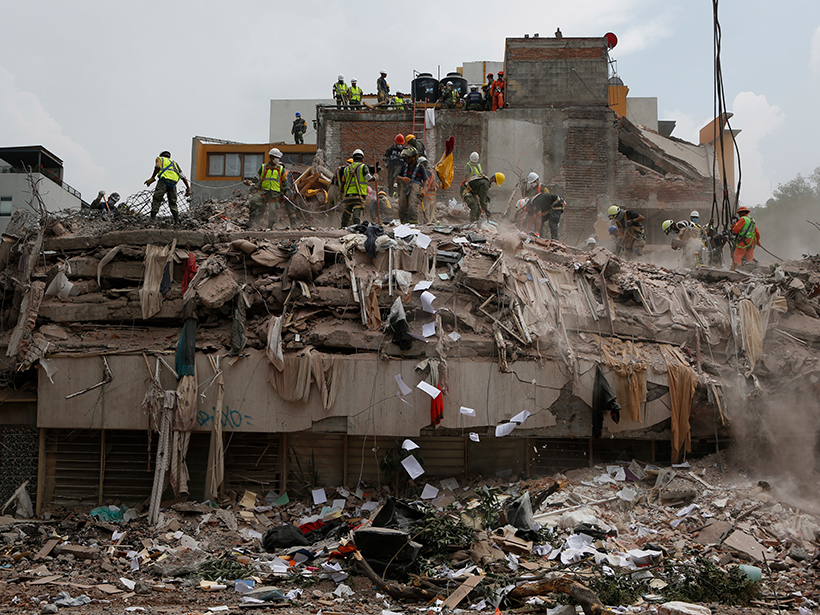Four months ago, a magnitude 8.1 earthquake and subsequent tsunami brought death and destruction to Mexico’s Gulf of Tehuantepec, an area that hadn’t seen strong earthquakes in 2 centuries. Less than 2 weeks later, a 7.1 quake rocked Mexico City, the nation’s capital, and the nearby populous region of Puebla.
A natural question arises. “Did the earthquakes occur in a chain reaction or by coincidence?” asked Shinji Toda of Tohoku University in Japan.
According to analysis that he completed with Ross Stein of Temblor in Redwood City, Calif., the latter explanation is more likely. Toda presented his team’s earthquake modeling study last month at the American Geophysical Union’s 2017 Fall Meeting in New Orleans, La.
No Trigger
The first of the earthquakes began on 7 September 2017 local time along the Tehuantepec Ridge, off Mexico’s Pacific coast near Guatemala. There, a slab of Earth’s crust called the Cocos Plate is gradually pushing beneath the vast North American Plate on which the Mexican mainland sits.
This subduction is not smooth: Forces akin to friction tend to cause the plates to stick together. On that day, the forces pushing the Cocos Plate suddenly overcame this friction, causing an earthquake that sent seismic waves racing northeast and southwest through the rock at 3 to 3.5 kilometers per second, Toda explained.
Not enough transferred stress built up to have caused the rupture that jolted Mexico City and Puebla.
Toda and Stein calculated that the release of tension where the fault lurched added significant stress elsewhere along the same fault, which is oriented southeast–northwest along the coastline and extends into the region where the second earthquake took place. However, they determined that not enough transferred stress built up to have caused the rupture that jolted Mexico City and Puebla.
Some earthquakes can trigger tiny shocks that can cause a growing buildup of stress elsewhere, developing into another, possibly similarly sized quake. But when such a scenario has happened before, the follow-up quake usually takes place within a few days, unless aftershocks persist for longer, Stein noted.
In the case of the Tehuantepec earthquake, Toda and Stein’s model shows that the quake did not provoke new sets of seismic waves in Mexico City and Puebla. Instead, the quake’s shocks faded away in that region, allowing seismic activity to abate there.
Then, on 19 September 2017, the ground beneath Mexico City and Puebla began to shake. Despite this shaking occurring only 600 kilometers away from the epicenter of the Tehuantepec earthquake, it struck too long afterward to have arisen from it, according to Toda and Stein’s analysis. “We don’t see any evidence of triggered events,” Toda said. In other words, one quake did not set off the other.
A Matter of Chance
The occurrence of the Tehuantepec and Puebla earthquakes in the same year, let alone less than 2 weeks apart, was exceedingly unlikely.
The Tehuantepec and Puebla earthquakes each had about a 0.5% chance annually of occurring on the basis of Toda and Stein’s modeling. Hence, their occurrence in the same year, let alone less than 2 weeks apart, was exceedingly unlikely.
Given the distance separating them and the range of territory affected by each of the quakes, Toda estimates about a 1 in 200 chance of them happening so close together. That’s rather small but not impossible. He likens it to the “birthday problem,” in which you have a 50% chance of finding two individuals in a group of 23 randomly selected people who were born on the same month and day.
However, the Puebla quake struck just 2 hours after Mexico’s national earthquake drill, a synchrony that’s even more highly improbable; Toda estimates the odds at 1 in 900,000.
“There are two types of chance, temporal chance and spatial chance,” said Xyoli Pérez-Campos, director of Mexico’s National Seismological Service in Mexico City. On both counts, she argued, the 19 September quake “was completely unexpected,” agreeing with Toda’s analysis.
Searching for Stress
Although the Tehuantepec quake did not cause enough stress to build up and trigger the earthquake that shook Puebla and Mexico City, Toda and Stein argue that it did push stress elsewhere. Their work shows that the initial Tehuantepec shock likely contributed to a third quake, magnitude 6.1, which coursed through the neighboring state of Oaxaca on 23 September 2017.

The first earthquake slightly increased the stress in the fault that ultimately ruptured in Oaxaca, the researchers’ model indicated. As a result, the Oaxaca quake may have simply been a large aftershock of the Tehuantepec one.
Toda and Stein estimate a 30%–55% chance of another quake of magnitude 7 or greater in the 12 months following the Tehuantepec event.
But the Oaxaca quake may not have been the last domino to fall. Toda and Stein’s modeling of the stress transferred to surrounding regions from the Tehuantepec quake and its aftershocks led them to estimate a 30%–55% chance of another quake of magnitude 7 or greater in the 12 months following the Tehuantepec event. This quake would most likely be centered in an area near Acapulco known as the “Guerrero seismic gap,” according to their models.
The northwest part of the Guerrero seismic gap has seen a slightly higher seismicity rate since September but hasn’t experienced a major quake in more than a century. Does that mean one is overdue?
Perhaps, noted Stein. “Earthquakes tend to beget earthquakes,” he said.
—Ramin Skibba (email: [email protected]; @raminskibba), Freelance Science Journalist
Citation:
Skibba, R. (2018), Were Mexico’s September quakes chance or a chain reaction?, Eos, 99, https://doi.org/10.1029/2018EO091619. Published on 30 January 2018.
Text © 2018. The authors. CC BY-NC-ND 3.0
Except where otherwise noted, images are subject to copyright. Any reuse without express permission from the copyright owner is prohibited.

